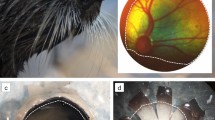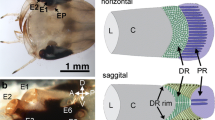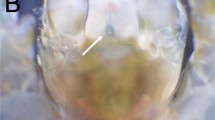Summary
-
1.
In order to analyse the mechanism of accommodation in anurans, drugs (miotic or atropine) were applied to the cornea of anaesthetized animals to change the refractive state of their eyes. During such changes, the lens and cornea were photographed and the refractive state of the eye was measured using laser speckle refractometry. Measurements taken from the photographs confirmed suggestions by Beer (1898) that accommodation is achieved by moving the lens and not by changing the shape of the lens or cornea. The change in refractive state induced by pharmacological manipulation was about 10 diopters with an accompanying shift in lens position of about 150 μm. Calculations based on a schematic eye suggest a disparity between the amount of lens movement theoretically needed to produce a 10 D shift in refractive state and the amount actually observed.
-
2.
The lens is probably moved by two protractor lentis muscles which are positioned so as to pull the lens towards the cornea (Tretjakoff 1906, 1913). Dissection and HRP preparations revealed that these muscles are innervated by fibres of the oculomotor nerve which relay in the ciliary ganglion. InR. esculenta andR. pipiens, the ciliary ganglion consists of only 8 to 12 nerve cells.
-
3.
MS222 anaesthesia and lymphatic injection of curare cause the lens to move away from the cornea, presumably because they destroy the resting tonus of the protractor lentis muscles. We discuss this finding in relation to the frog's ‘resting’ accommodative state, and conclude that unparalysed frogs are likely to be myopic, and not emmetropic as previous work suggests.
-
4.
Prey capture was analysed inR. pipiens after the disruption of accommodation by bilateral section of the oculomotor nerve. Estimates of prey distance remained accurate when vision was binocular. However, during monocular vision, when the oculomotor nerve was sectioned on one side and the other eye was either occluded or had its optic nerve cut, frogs consistently underestimated the distance of their prey. This result suggests, in agreement with earlier evidence, that accommodation is used for judging depth when vision is limited to one eye, but that binocular information predominates when it is available.
-
5.
Atropine applied to the cornea of monocular frogs also causes distance to be underestimated. It is argued from this that frogs assess distance by monitoring the motor commands sent to their accommodative muscles, rather than by using sensory information from the muscles themselves.
Similar content being viewed by others
References
Beer T (1898) Die Accommodation des Auges bei den Amphibien. Arch Ges Physiol 73:501–534
Burn JH (1975) The autonomic nervous system. Blackwell Scientific Publications, Oxford London Edinburgh Melbourne
Collett TS (1977) Stereopsis in toads. Nature 267:349–351
Collett TS, Harkness L (1982) Distance vision in animals. In: Ingle DJ, Goodale M, Mansfield RJW (eds) Advances in the analysis of visual behaviour. MIT Press, Cambridge Mass, London
du Pont JS, de Groot PJ (1976) A schematic dioptric apparatus for the frog's eye (Rana esculenta). Vision Res 16:803–810
Glickstein M, Millodot M (1970) Retinoscopy and eye size. Science 168:605–606
Green DG, Powers MK, Banks MS (1980) Depth of focus, eye size and visual acuity. Vision Res 20:827–835
Hess C (1911) Beiträge zur vergleichenden Accomodationslehre. Zool Jahrb 30:339–359
Hirschberg I (1882) Zur Dioptrik and Ophthalmoskopie der Fisch- und Amphibienaugen. Arch Anat Physiol Abt Physiol 1882:493–526
Hughes A (1977) The topography of vision in mammals. In: Crescitelli F (ed) The visual system in vertebrates. (Handbook of sensory physiology, vol VII/5). Springer, Berlin Heidelberg New York, pp 613–756
Ingle DJ (1972) Depth vision in monocular toads. Psychon Sci 29:37–38
Jordan M, Luthardt G, Meyer-Naujoks Chr, Roth G (1980) The role of eye accommodation in the depth perception of common toads. Z Naturforsch 35c: 851–852
Krueger H, Moser EA (1971) Refraktion and Abbildungsgesetze des Froschauges. Pflügers Arch 326:334–340
Manteuffel G, Wess O, Himstedt W (1977) Messungen am dioptrischen Apparat von Amphibienaugen und Berechnung der Sehschärfe in Wasser und Luft. Zool Jb Physiol 81:395–406
Meyer DL, Schwassmann HO (1970) Elektrophysiological method for determination of refractive state in fish eyes. Vision Res 10:1301–1303
Millodot M (1971) Measurement of the refractive state of the eye in frogs (Rana pipiens). Rev Can Biol 30:249–252
Millodot M (1974) Optical measurement of the refraction of the eyes in frogs (Rana pipiens). Pflügers Arch 351:173–175
Millodot M, Sivak J (1978) Hymermetropia of small animals and chromatic aberration. Vision Res 18:125–126
Moser EA, Krueger H (1972) Retinoscopic and neurophysiological refractometry inRana temporaria. Pflügers Arch 335:235–242
Podufal G (1971) Zur Entfernungsmessung und Größenbeurteilung durch die Erdkröte (Bufo bufo L.). Dissertation, Göttingen
Richardson KC, Jarett L, Finke EH (1960) Embedding in epoxy resins for ultrathin sectioning in electron microscopy. Stain Technol 35:313–323
Rolls P (1968) In: Engle CN (ed) Photography for the scientist. Academic, New York
Sivak JG (1980) Accommodation in vertebrates: a contemporary survey. Curr Top Eye Res 3:281–330
Tretjakoff D (1906) Die vordere Augenhälfte des Frosches. Z Wiss Zool 80:327–410
Tretjakoff D (1913) Zur Anatomie des Auges der Kröte. Z Wiss Zool 105:537–573
Walls GL (1942) The vertebrate eye and its adaptive radiation. Hafner Publishing Co., New York London
Westheimer G, Blair SM (1973) Accommodation of the eye during sleep and anesthesia. Vision Res 13:1035–1040
Author information
Authors and Affiliations
Rights and permissions
About this article
Cite this article
Douglas, R.H., Collett, T.S. & Wagner, H.J. Accommodation in anuran Amphibia and its role in depth vision. J. Comp. Physiol. 158, 133–143 (1986). https://doi.org/10.1007/BF00614527
Accepted:
Issue Date:
DOI: https://doi.org/10.1007/BF00614527




